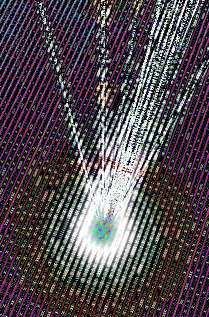Quantum circuit goes live
 Australian researchers say they have created the world’s first quantum integrated circuit manufactured at the atomic scale.
Australian researchers say they have created the world’s first quantum integrated circuit manufactured at the atomic scale.
Australian quantum computing manufacturer, Silicon Quantum Computing (SQC), has announced they have developed a quantum computing chip that integrates all the necessary components found on a classical computer chip but at the atomic scale, making up a functional quantum processor.
Delivery of this atomic-scale integrated circuit, which operates as an analogue quantum processor, has come less than a decade after the team declared that it had fabricated the world’s first single atom transistor and has been achieved two years ahead of schedule.
The team at SQC has used this quantum processor to accurately model the quantum states of a small, organic polyacetylene molecule – definitively proving the validity of the company’s technology for modelling quantum systems.
“This is a major breakthrough,” says SQC founder, Michelle Simmons.
“Today’s classical computers struggle to simulate even relatively small molecules due to the large number of possible interactions between atoms.
“Development of SQC’s atomic-scale circuit technology will allow the company and its customers to construct quantum models for a range of new materials, whether they be pharmaceuticals, materials for batteries, or catalysts. It won’t be long before we can start to realise new materials that have never existed before.”
To build the processor, SQC had to integrate multiple atomic components within a single device, which it did from its facility in Sydney.
The new quantum processor meets the stringent requirements for scaling quantum computing hardware. It represents a major technical milestone on the road to achieving the company’s goal of delivering an error-corrected processor.
The processor delivers on a challenge first postulated by pioneering theoretical physicist Professor Richard Feynman in his famous 1959 lecture ‘Plenty of Room at the Bottom’.
In this lecture, Dr Feynman asserted that if humanity wants to understand how nature works, then it has to be able to control matter at the same length scales from which matter is constructed – i.e. being able to control matter down at the length scale of atoms.
Sixty-three years after Feynman first put forward this foundational theory, Dr Simmons and her team have proven out this conjecture and built an integrated circuit using atomic components in silicon.
To achieve the first quantum integrated circuit SQC required realisation of three separate technological feats of atomic engineering.
The first was to create such small dots of atoms of uniform size so that their energy levels aligned and electrons could easily pass through them.
The second was the ability to tune the energy levels of each dot individually, but also of all dots collectively, to control the passage of quantum information.
The third was the teams’ ability to control the distances between the dots with sub-nanometre precision so that the dots were close enough but remained independent for the quantum coherent transport of electrons across the chain.
SQC is now scaling its quantum hardware to take on heavy duty computational tasks that cannot be performed by traditional computers.







 Print
Print